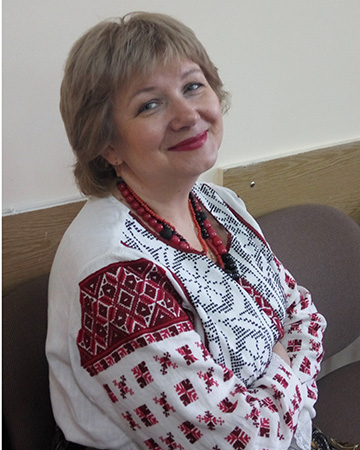|
 UDC 628.4+658.567; JEL O13, Q21, Q28, Q39
UDC 628.4+658.567; JEL O13, Q21, Q28, Q39
Kulish, I., & Kaplenko, H. (2022). Osoblyvosti povodzhennya z medychnymy vidkhodamy [Features of medical waste management]. In Sotsial'no-ekonomichni problemy suchasnoho periodu Ukrayiny [Socio-Economic Problems of the Modern Period of Ukraine]: Vol. 153 (1) (pp. 24-31). DOI: https://doi.org/10.36818/2071-4653-2022-1-4. [in Ukrainian].
Sources: 19
Authors
Kulish Inna MykhaylivnaPh.D. of Public Administration, Senior Researcher
Senior Researcher of the Department of regional ecological policy and environmental management of the Dolishniy Institute of Regional Research of NAS of Ukraine
Contacts:  inna.m.kulish@gmail.com, inna.m.kulish@gmail.com,  reksi@email.ua reksi@email.ua
Webpages:         

Kaplenko Halyna ViktorivnaDoctor of Economics, Professor
Head of the Department of economics and public administration of the Faculty of Finance Management and Business of the Ivan Franko National University of Lviv
Contacts:  haliakapl@gmail.com, haliakapl@gmail.com,  halyna.kaplenko@lnu.edu.ua halyna.kaplenko@lnu.edu.ua
Webpages:        
ResumeThe article argues that all medical waste requires a special approach as experience has shown that many substances used as safe pose a threat to human health and human life and cause irreparable damage to the environment. The expediency of reviewing certain categories of medical waste with their subsequent transfer to the category of household waste (office paper, office furniture, etc.) is specified. The need to pay more attention to waste in the cosmetics and perfume industry is emphasized as more and more pharmaceutical and chemical substances are used in this production. The article detects significant differences in some statistical indicators by year and the combination of medical and non-medical waste in one indicator, which indicates the imperfection of statistical accounting. The adequacy of medical waste management is revealed to depend on the standard of living in the country and the availability of effective public policy in this area, as well as the availability of natural resources in the required amount. The historical retrospective shows the changes in the attitude to disposable and reusable medical materials. The authors propose to use a table comparing the cost of disposal from different points of view, taking into account the necessary sanitary and hygienic requirements. The need to strengthen control over the rational use of disposable medical devices is emphasized, which in some cases makes it possible to significantly reduce the amount of waste and general medical expenses. A comparative analysis of the cost of medical waste disposal in the United States and Ukraine is conducted. The analysis shows that the United States has lower prices. Despite the rather carefully prescribed procedure for obtaining a license for activities in the field of medical waste management, the numerous abuses identified by inspections indicate the need to improve it.
Keywords:medical waste, hazardous waste, recycling, recycling plant, permit documentation, environment, healthcare
References- Shaping our future together. Shifting Demographics (2021). United Nations: Website. Retrieved from https://www.un.org/en/un75/shifting-demographics
- Marti, E., Variatza, E., & Balcaza, J. L. (2014). The role of aquatic ecosystems as reservoirs of antibiotic resistance. Trends in Microbiology. Vol. 22(1), 36-41. DOI: https://doi.org/10.1016/j.tim.2013.11.001
- Caliman, F. A., & Gavrilescu, M. (2009). Pharmaceuticals, Personal Care Products and Endocrine Disrupting Agents in the Environment – A Review. CLEAN-Soil, Air, Water, 37(4-5), 277-303. DOI: https://doi.org/10.1002/clen.200900038
- Narvaez, J. F., & Jiménez, C. (2012). Pharmaceutical Products in the Environment: Sources, Effects and Risks. Vitae, 19(1), 92-108. Retrieved from https://revistas.udea.edu.co/index.php/vitae/article/view/10865
- Health-care waste (2018, Feb 08). World Health Organization: Website. Retrieved from https://www.who.int/news-room/fact-sheets/detail/health-care-waste
- Pro zatverdzhennya Derzhavnykh sanitarno-protyepidemichnykh pravyl i norm shchodo povodzhennya z medychnymy vidkhodamy [On approval of the State sanitary and anti-epidemic rules and norms on medical waste management] (2015). Order of the Ministry of Health of Ukraine, adopted on 2015, Jun 08, 325. Legislation of Ukraine: Website. Retrieved from https://zakon.rada.gov.ua/laws/show/z0959-15#Text [in Ukrainian].
- Water, sanitation and hygiene in health care facilities: status in low and middle income countries and way forward (2015). Geneva: WHO Press.
- State Statistics Service of Ukraine: Website (2022). Retrieved from http://www.ukrstat.gov.ua [in Ukrainian].
- SWA collaborative behaviours: country profiles 2017 (2017). SWA: Website. Retrieved from https://www.sanitationandwaterforall.org/sites/default/files/migrate_default_content_files/Peru_CB_Profile_2017_For_Web.pdf
- How do you fix healthcare’s medical waste problem? (2020, Aug 14). BBC: Website. Retrieved from https://www.bbc.com/future/article/20200813-the-hidden-harm-of-medical-plastic-waste-and-pollution.
- Conrardy, J., Hillanbrand, M., Myers, S., & Nussbaum, G. F. (2010). Reducing Medical Waste. AORN Journal, 91(6), 711-721. DOI: https://doi.org/10.1016/j.aorn.2009.12.029
- Medical waste: why it is so important to dispose of it correctly (2021, Oct 25). United Nations Development Programme: Website. Retrieved from https://www.kg.undp.org/content/kyrgyzstan/en/home/presscenter/articles/2021/10/disposing-medical-waste.html
- Hazardous Waste Management. Solutions and Expertise that Starts With You (2021). MCF: Website. Retrieved from https://mcfenvironmental.com/why-choose-us
- Povodzhennya iz medychnymy vidkhodamy [Medical waste management] (2020, Apr 02). State Ecological Inspectorate of Ukraine: Website. Retrieved from https://www.dei.gov.ua/posts/828 [in Ukrainian].
- Pro zatverdzhennya Litsenziynykh umov provadzhennya hospodars’koyi diyal’nosti z povodzhennya z nebezpechnymy vidkhodamy [On approval of the Licensing Conditions for Hazardous Waste Management] (2016). Resolution of the Cabinet of Ministers of Ukraine, adopted on 2016, Jul 13, 446. Uryadovyy kur’yer – Government courier, 132. [in Ukrainian].
- Ministry of Environmental Protection and Natural Resources of Ukraine: Website (2022). Retrieved from https://mepr.gov.ua [in Ukrainian].
- Pro zatverdzhennya protyepidemichnykh zakhodiv povodzhennya z medychnymy vidkhodamy, shcho utvoryuyut’sya vnaslidok provedennya kampaniyi masovoyi vaktsynatsiyi naselennya vid koronavirusnoyi khvoroby (COVID-19) [On approval of anti-epidemic measures for the treatment of medical waste generated as a result of the campaign of mass vaccination of the population against coronavirus disease (COVID-19)] (2022). Resolution of the Ministry of Health of Ukraine, adopted on 2022, Feb 10, 14. Legislation of Ukraine: Website. Retrieved from https://zakon.rada.gov.ua/rada/show/v0014488-22#Text [in Ukrainian].
- Lisnychenko, P. (2021, Jan19). Utylizatsiya koronavirusnykh medvidkhodiv [Utilization of coronavirus medical waste]. Dozorro: Website. Retrieved from https://dozorro.org/blog/utilizaciya-koronavirusnih-medvidhodiv [in Ukrainian].
- Strelchenko, O. H., & Bukhtiyarova, I. H. (2021). Osoblyvosti administratyvno-pravovoho rehulyuvannya povodzhennya iz medychnymy vidkhodamy [Features of administrative and legal regulation of medical waste management]. Visnyk Luhans’koho derzhavnoho universytetu vnutrishnikh sprav imeni E. O. Didorenka – Bulletin of Luhansk State University of Internal Affairs named after E. Didorenko, 2(94), 156-169. DOI: https://doi.org/10.33766/2524-0323.94.156-170 [in Ukrainian].
|